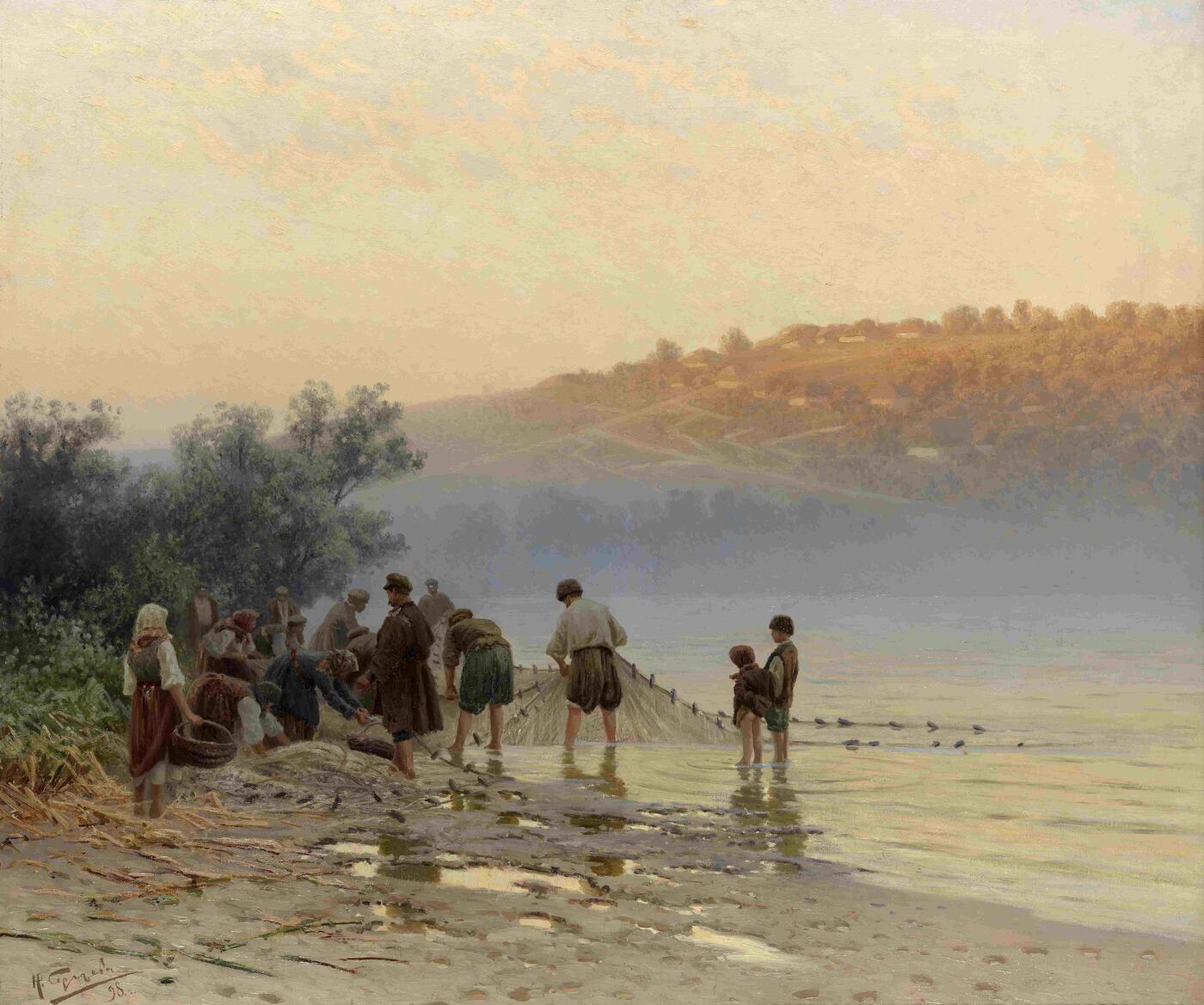MacDougall's Russian Art Auctions 1-2 Dec 2010
1 December 2010

338. SERGEEV, NIKOLAI 1855-1919
Bay on the Dnieper signed and dated 1898
Oil on canvas, 129 by 151.5 cm.
120,000-180,000 GBP
Authenticity has been confirmed by the expert V. Petrov.
Related Literature: For an engraving of this work executed by Khmelnitsky, see Niva Magazine, 1899.
Bay on the Dnieper by the outstanding Malorussian artist Nikolai Sergeev, is known in two equally good versions. One of these, painted in 1888, is today in the ownership of the Sukachev State Art Museum in Irkutsk and the other, executed ten years later, is offered here for auction.
Both of these major works portray the same genre scene, unfolding on the picturesque banks of the Dnieper. Village children alongside adults are dragging a sweep-net full of fish from the river. Up to their knees in water, they are straining to drag the heavy, water-logged net to the bank, and barefoot peasant girls are piling the catch into large wicker baskets.
When Sergeev had finished his first version of the Dnieper bay picture, he immediately submitted it to the 1889 Academy exhibition, where the picture won not only public acclaim but also the approval of the art critics, who were usually somewhat hostile towards art lacking democratic tendencies. Thus the periodical Khudozhestvennye Novosti wrote that "Sergeev’s works are distinguished by a serious attitude towards his profession and a highly developed technique. Two pictures by this artist, Dying Stars and Bay on the Dnieper, are very good." Despite the success of Bay on the Dnieper, when Sergeev applied himself again to the subject a decade later, he did not simply repeat a motif which was popular with the public but created a different and self-contained work. The basic approach he took for the re-arrangement of the "good catch" painting was not only to shift the centre of the action from the middle to the left, under a large, spreading tree on the bank, but also, more importantly, to change the lighting. For the play of light and the portrayal of its elusive effects were among the main motifs of this artist’s work. The way light would transform nature, unfolding its variations to our view throughout the day, always made a great impact on Sergeev, and he was constantly striving to capture them, to fix them on canvas. The artist was especially drawn to the moment when the sunlight is at its greatest, when the sultry mid-day heat fills the air with radiance, and objects cast a dense, sharply-defined shadow, and to the transient lighting conditions we experience just before sunset or just before dawn. The two versions of Bay on the Dnieper are based on exactly that lighting contrast. While, in the Irkutsk work, the action is played out on the smooth surface of the Dnieper’s waters, suffused with sunlight, and the distant, uninhabited, hilly bank appears green, with jagged shadows, meadows and copses, the present version portrays a warm Ukrainian evening. The sun is just beginning to set. The river, broad and sweeping, disappears into the distance. On the opposite bank is a sleepy little croft. It is evening, when mist rises from the river and everything around trembles in a vague, ill-defined haze. In the smooth, mother-of-pearl surface of the water, dissolving into the mist, the sky, with all its delicate colour nuances, is reflected as in a mirror.
At the beginning of the 20th century, the evening version of Bay on the Dnieper became no less popular than its day-time counterpart, thanks to the publication of engravings of this painting by Khmelnitsky and Damueller. Under the title Fishermen, they were published in the popular periodicals Niva and Sever, re-acquainting their readers from time to time with Sergeev’s paintings.
Notes on symbols:
* Indicates 5% Import Duty Charge applies.
Ω Indicates 20% Import Duty Charge applies.
§ Indicates Artist's Resale Right applies.
† Indicates Standard VAT scheme applies, and the rate of 20% VAT will be charged on both hammer price and premium.